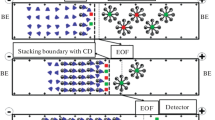Abstract
The electrostatic interaction between additive and analyte is of great importance to non-aqueous capillary electrophoresis (NACE) separation. Three tetraalkylammonium bromides and acetonitrile were applied as additives and running solvent respectively. The effect of alkyl chain length and concentration of additive on electrostatic interactions was investigated by the separation of phenols. The separation ability was found to increase with decreasing alkyl chain length of the additive, and the resolution values were increased with increasing additive concentration. The separation was seriously deteriorated after a little amount of water was added in the running solution. Furthermore, the electrostatic interaction is strong under the conditions of low electron cloud density, weak steric hindrance and multi-interaction sites. Thus, the separation result can be predicted by theoretical analysis, which is helpful for the separation of other substances in NACE based on electrostatic interaction.
Similar content being viewed by others
References
Walbroehl Y, Jorgenson J W. On-column UV absorption detector for open tubular capillary zone electrophoresis. J Chromatogr, 1984, 315: 135–143
Flores J R, Nevado J J B, Peñalvo G C, et al. Development and validation method for determination of fluoxetine and its main metabolite norfluoxetine by nonaqueous capillary electrophoresis in human urine. Talanta, 2005, 65(1): 163–171
Segio M, Rafael C. Field-amplified sample staking and nonaqueous capillary electrophoresis determination of complex mixtures of polar aromatic sulfonates. Electrophoresis, 2002, 23(3): 408–413
Song J Z, Xu H X, Tian S J, et al. Determination of quinolizidine alkaloids in traditional Chinese herbal drugs by nonaqueous capillary electrophoresis. J Chromatogr A, 1999, 857(1–2): 303–311
Altria K D, Wallberg M, Westerlund D. Separation of a range of cations by nonaqueous capillary electrophoresis using indirect and direct detection. J Chromatogr B, 1998, 714(1): 99–104
Chiari M, Kenndler E. Capillary zone electrophoresis in organic solvents: Separation of anions in methanolic buffer solutions. J Chromatogr A, 1995, 716(1–2): 303–309
Browser M T, Kranack A R, Chen D D Y. Analyte-additive interactions in nonaqueous capillary electrophoresis: A critical review. Trac-trends Anal Chem, 1998, 17(7): 424–434
Okada T. Non-aqueous capillary electrophoretic separation of polyethers and evaluation of weak complex formation. J Chromatogr A, 1995, 695(2): 309–317
Miller J L, Khaledi M G, Shea D. Separation of hydrophobic solutes by nonaqueous capillary electrophoresis through dipolar and charge-transfer interactions with pyrylium salts. J Microcolumn Sep, 1998, 10(8): 681–685
Tjørnelund J, Hansen S H. Separation of neutral substances by non-aqueous capillary electrophoresis through interactions with cationic additives. J Chromatogr A, 1997, 792(1–2): 475–482
Porras S P, Kuldvee R, Palonen S, et al. Capillary electrophoresis of methyl-substituted phenols in acetonitrile. J Chromatogr A, 2003, 990(1–2): 35–44
Okada T. Non-aqueous capillary electrophoresis separation of Brønsted acids as hetero-conjugated anions. J Chromatogr A, 1997, 771(1–2): 275–284
Walbroehl Y, Jorgenson J W. Capillary zone electrophoresis of neutral organic molecules by solvophobic association with tetraalkylammonium ion. Anal Chem, 1986, 58(2): 479–482
Izutsu K. Electrochemistry in Nonaqueous Solutions. Gebunden: Wiley-VCH, 2002. 31–32
Author information
Authors and Affiliations
Corresponding author
Additional information
Supported by the National Natural Science Foundation of China (Grant No. 20375051) and the Excellent Young Teachers Program of Ministry of Education (Grant No. [2002]123)
Rights and permissions
About this article
Cite this article
Wei, W., Yin, Y., Xia, Z. et al. Electrostatic interaction mechanism on the separation of phenols by non-aqueous capillary electrophoresis. SCI CHINA SER B 50, 47–53 (2007). https://doi.org/10.1007/s11426-007-0018-8
Received:
Accepted:
Issue Date:
DOI: https://doi.org/10.1007/s11426-007-0018-8



